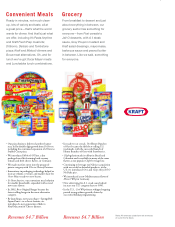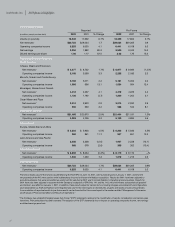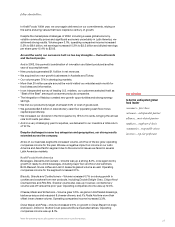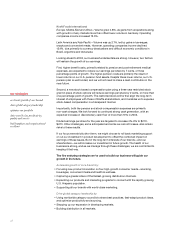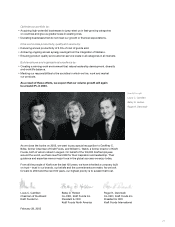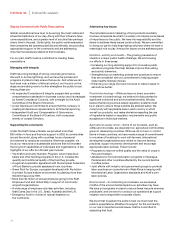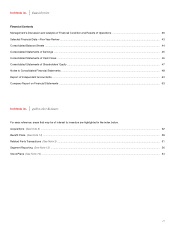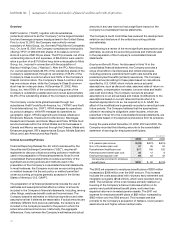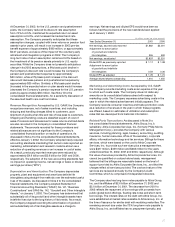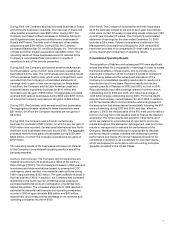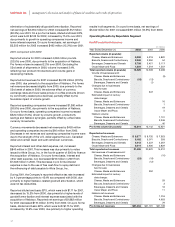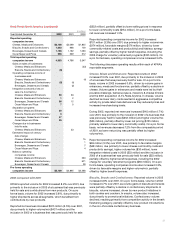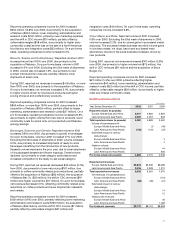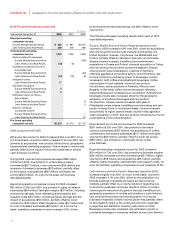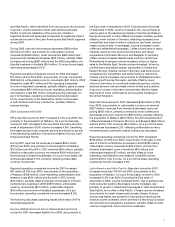Kraft 2002 Annual Report Download - page 31
Download and view the complete annual report
Please find page 31 of the 2002 Kraft annual report below. You can navigate through the pages in the report by either clicking on the pages listed below, or by using the keyword search tool below to find specific information within the annual report.
At December 31, 2002, for the U.S. pension and postretirement
plans, the Company reduced its discount rate assumption
from 7.0% to 6.5%, maintained its expected return on asset
assumption at 9.0%, and increased its medical trend rate
assumption. The Company presently anticipates that these
assumption changes, coupled with lower returns on pension fund
assets in prior years, will result in an increase in 2003 pre-tax
benefit expense of approximately $180 million, or approximately
$0.07 per share, exclusive of the impact of the voluntary early
retirement and integration programs in 2002. The Company’s
long-term rate of return assumption remains at 9.0% based on
the investment of its pension assets primarily in U.S. equity
securities. While the Company does not presently anticipate a
change in its 2003 assumptions, a fifty basis point decline in
the Company’s discount rate would increase the Company’s
pension and postretirement expense by approximately
$50 million, while a fifty basis point increase in the discount
rate would decrease pension and postretirement expense by
approximately $35 million. Similarly, a fifty basis point decline
(increase) in the expected return on plan assets would increase
(decrease) the Company’s pension expense for the U.S. pension
plans by approximately $35 million. See Note 14 to the
consolidated financial statements, for a sensitivity discussion of
the assumed health care cost trend rates.
Revenue Recognition: As required by U.S. GAAP, the Company
recognizes revenues, net of sales incentives, and including
shipping and handling charges billed to customers, upon
shipment of goods when title and risk of loss pass to customers.
Shipping and handling costs are classified as part of cost of
sales. Provisions and allowances for sales returns and bad debts
are also recorded in the Company’s consolidated financial
statements. The amounts recorded for these provisions and
related allowances are not significant to the Company’s
consolidated financial position or results of operations. As
discussed in Note 2 to the consolidated financial statements,
effective January 1, 2002, the Company adopted newly required
accounting standards mandating that certain costs reported as
marketing, administration and research costs be shown as a
reduction of operating revenues or an increase in cost of sales.
As a result, previously reported revenues were reduced by
approximately $4.6 billion and $3.6 billion for 2001 and 2000,
respectively. The adoption of the new accounting standards had
no impact on operating income, net earnings or basic or diluted
earnings per share (“EPS”).
Depreciation and Amortization: The Company depreciates
property, plant and equipment and amortizes definite life
intangibles using straight-line methods over the estimated useful
lives of the assets. As discussed in Note 2 to the consolidated
financial statements, the Company adopted Statement of
Financial Accounting Standards (“SFAS”) No. 141, “Business
Combinations” and SFAS No. 142, “Goodwill and Other Intangible
Assets,” on January 1, 2002. The Company has determined that
substantially all of its goodwill and other intangible assets have
indefinite lives due to the long history of its brands. As a result,
the Company stopped recording the amortization of goodwill
and substantially all of its intangible assets as a charge to
earnings. Net earnings and diluted EPS would have been as
follows had the provisions of the new standards been applied
as of January 1, 2000:
(in millions, except per share amounts)
Year Ended December 31, 2001 2000
Net earnings, as previously reported $1,882 $2,001
Adjustment for amortization
of goodwill and indefinite
life intangibles 955 530
Net earnings, as adjusted $2,837 $2,531
Diluted EPS, as previously reported $ 1.17 $ 1.38
Adjustment for amortization
of goodwill and indefinite
life intangibles 0.59 0.36
Diluted EPS, as adjusted $ 1.76 $ 1.74
Average diluted shares outstanding 1,610 1,455
Marketing and Advertising Costs: As required by U.S. GAAP,
the Company records marketing costs as an expense in the year
to which such costs relate. The Company does not defer any
amounts on its consolidated balance sheet with respect to
marketing costs. The Company expenses advertising costs in the
year in which the related advertisement initially appears. The
Company records consumer incentive and trade promotion costs
as a reduction of revenues in the year in which these programs
are offered, based on estimates of utilization and redemption
rates that are developed from historical information.
Related Party Transactions: As discussed in Note 3 to
the consolidated financial statements, Altria Group, Inc.’s
subsidiary, Altria Corporate Services, Inc. (formerly Philip Morris
Management Corp.), provides the Company with various
services, including planning, legal, treasury, accounting, auditing,
insurance, human resources, office of the secretary, corporate
affairs, information technology and tax services. Billings for these
services, which were based on the cost to Altria Corporate
Services, Inc. to provide such services plus a management fee,
were $327 million, $339 million and $248 million for the years
ended December 31, 2002, 2001 and 2000, respectively. Although
the value of services provided by Altria Corporate Services, Inc.
cannot be quantified on a stand-alone basis, management
believes that the billings are reasonable based on the level of
support provided by Altria Corporate Services, Inc., and that the
charges reflect all services provided. The cost and nature of the
services are reviewed annually by the Company’s Audit
Committee, which is comprised of independent directors.
The Company also has long-term notes payable to Altria Group,
Inc. and its affiliates of $2.6 billion at December 31, 2002 and
$5.0 billion at December 31, 2001. The decrease from 2001 to
2002 reflects the repayment of borrowings with proceeds from
public global bond offerings, floating rate notes and short-term
borrowings. The interest rates on the debt with Altria Group, Inc.
were established at market rates available to Altria Group, Inc. at
the time of issuance for similar debt with matching maturities. The
remaining amount due under the 7.0% long-term note payable to
Altria Group, Inc. and affiliates has no prepayment penalty, and
27




